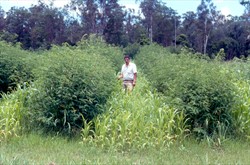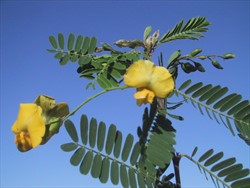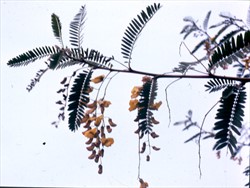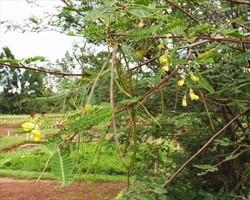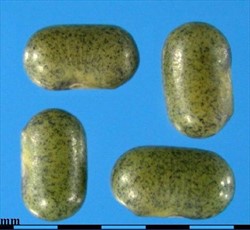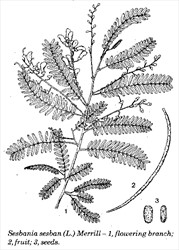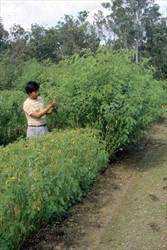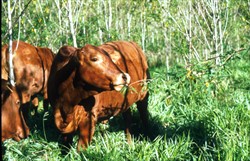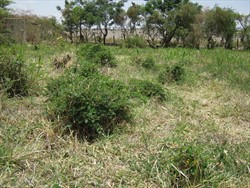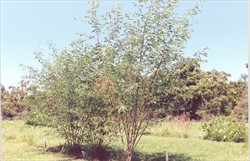Sesbania sesban
Tropical Forages
Sesbania sesban (L.) Merr.
Subordinate taxa:
Sesbania sesban (L.) Merr. subsp. muricata Baquar
Sesbania sesban (L.) Merr. subsp. punctata (DC.) J.B. Gillett
Sesbania sesban (L.) Merr. subsp. sesban
Sesbania sesban (L.) Merr. subsp. sesban var. bicolor (Wight & Arn.) F.W. Andrews
Sesbania sesban (L.) Merr. subsp. sesban var. nubica Chiov.
Sesbania sesban (L.) Merr. subsp. sesban var. sesban
Sesbania sesban (L.) Merr. subsp. sesban var. zambesiaca J.B. Gillett
subsp. punctata: Basionym: Sesbania punctata DC.
var. bicolor: Basionym: Sesbania aegyptiaca var. bicolor Wight & Arn.
var. sesban: Basionym: Aeschynomene sesban L.; Sesban aegyptiacus Poir., orth. var.; Sesbania aegyptiaca Poir.
Family: Fabaceae (alt. Leguminosae) subfamily: Faboideae tribe: Sesbanieae.
Deep-rooted, short-lived (to 10 years) shrub or small tree 2‒4 (‒8) m tall. Main stem 6‒8 (‒12) cm in diameter; many side branches from low down on the bole; younger stems usually pubescent, sometimes becoming glabrous. Stipules triangular-lanceolate, 3‒4 (‒7) mm, caducous, pubescent. Leaves paripinnate, 2‒18 cm long; pinnae linear-oblong to oblong-lanceolate, opposite or nearly so in 6‒27 pairs, 13‒26 mm long, 3‒4 (‒6) mm wide, both surfaces with dark purplish glands, abaxially sparsely appressed pubescent when young but glabrescent, adaxially glabrous or glabrescent, midvein evident on both surfaces, base obliquely rounded, apex rounded to retuse and mucronate, often pilose at the margins. Racemes unbranched or branched, 2‒20-flowered, peduncle 2‒5 (‒10) cm long, rachis 2‒10 (‒20) cm long, glabrous or sparsely pilose; pedicels 4‒12 mm long, pubescent when young, glabrous. Calyx campanulate, green or dark purple, teeth shortly triangular. Corolla predominantly yellow or standard adaxially dark purple or purple spotted, abaxially yellow, red and purple, and wings and keel partly purplish black or red; standard transversely elliptic, 1.1‒1.3 cm, wider than long, with a 4‒5 mm claw; wings oblong, 1‒1.2 cm, with a curved ca. 4 mm claw, base inconspicuously auriculate, apex rounded; keel nearly semicircular, 6-8 × 5-7 mm, lamina base narrower than apex and with a triangular short auricle, claw ± as long as calyx. Pod subcylindrical, glabrous, straight or slightly curved, pendulous, 10‒20 (‒30) cm long, 2‒5 mm diameter, green to straw-coloured, often with a brown or reddish-brown blotch over each septum, 10‒30 (‒50) seeded. Seed subcylindrical, ends rounded, 3‒4.5 mm × 2 mm, olive-green or brown, usually mottled. 55,000‒80,000 seeds per kg.
Distinguishing features among the subspecies are considered weak, particularly when many are enviromentally influenced and/or continuously variable. Below are some of the distinguishing characteristics.
ssp. sesban: Pod twisted, distinctly torulose (swollen and constricted at intervals) inflorescences not branched; staminal tube 9‒13 mm
var. bicolor: calyx and standard purplish black, wings and keel partly purplish black or red; corolla standard callus blunt at apex; similar to var. sesban except for flower colour.
var. sesban: glabrous, flowers yellow.
var. zambesiaca: pubescent
ssp. punctata: Pod not twisted, not torulose when mature; inflorescence branched; staminal tube 15‒17 mm.
ssp. muricata: Differs from other subspecies in having the stem aculeate (prickles)
Africa: rivierboontjie (Afrikaans); girangire (Amharic); daisa (Boran, Ethiopia); tìNkpám, tìNkpámá (Dagbani, Ghana); kyerno (Hausa, Niger); loiyangalanyi (Dorobo,Suiei, Kenya); kinuka muhondo (Giriama, Tanzania/Kenya), zamorka (Hausa, Nigeria); mubimba (Haya, Tanzania); munyongo (Kamba, Kenya/Tanzania); natiantia (Keiyo, Kenya), mwethia (Kikuyu, Kenya); mizizum, mzizum (Kilongo, Angola); umunyegenyege (var. nubica, Kirundi, Burundi); omosabisabi (Kisii, Kenya); mubimba, muzimbandeya (Luganda, Uganda); chisubasubi, kumusubasubi, lukhule (Luhya, Kenya); kun’nayi (Lunda, Zambia/Angola); lusabasabi (Lunyore, Kenya); oyieko, osawa, osaosao, osawosawo, siaya, sawo sawo (Luo, Kenya/Tanzania); chiseke (Luvale, Angola/Zambia); enchini, harcha (Oromo, Ethiopia/Kenya/Somalia); ojengalani, ol ojengalani (Maasai, Kenya/Tanzania); walbaiyondet (Nandi, Kenya); mururume, murume (Nyamwezi, Luminu, Zaramo, Tanzania); loiyangalani (Samburu, Kenya); munyegeyege (Shi, Democratic Republic of the Congo); rakile lo’od, get beyo (Sidama, Ethiopia); tetem agazen, shashata (Tigrinya, Eritrea); moseletsi (tw?); mururume, murume (Zaramo, Tanzania); umkhumukhweqe, umQambuqweqwe, umsokosoko (Zulu, South Africa); mdolo, mundolo (Malawi); mpupunwa, mugunwa (Venda, N South Africa)
Arabic: saisabaan, saysaban, sesaban
Asia: 印度田菁 yin du tian jing (China); jayanti, janti, giyanti, kelor wana, puri (Indonesia); yay-tha-kyee, yethugyi (Myanmar); katuray, katodai (Philippines); snaô kôôk (Khmer, Cambodia); sapao lom (Laos); sami, saphaolom (Thailand); điên điển, điền thanh bụi (Vietnam)
Asia, South: jainti, jayant (Bengali); जयंती jainti, dhunchi, jait, rawasan (Hindi); jeenangi (Kannada); shewarie, shevari, vaijayanti (Marathi); thaitimul (Oriya); jaitaa, jayantii, jayanti (Nepalese); jainta (Punjabi); जयंतिका jayantika, jayanti (Sanskrit); champai, chithagathi, chittakatti, cirrakatti, karu-n-cempai, karunchembai (Tamil); chuchurangmei (Tangkhul); errajiluga (Telugu); jantar (Urdu)
English: common sesban, Egyptian pea, Egyptian rattle pod, Egyptian river hemp, iver, frother, river bean, sesban
German: gelbe Baumwisterie
Spanish: añil francés, tamarindillo
subsp. punctata
Native:
Africa: Cameroon (w.), Central African Republic; Côte d'Ivoire; Gambia; Ghana; Mali; Nigeria; Senegal; Sierra Leone; Sudan; Togo
subsp. sesban var. bicolor
Native:
Asia: India (probably)
Cultivated:
Asia: India
subsp. sesban var. nubica
Native:
Africa: Burundi; Chad; Democratic Republic of the Congo; Ethiopia; Kenya; Malawi; Mali (possibly); Mozambique; Nigeria (n.); Rwanda; Somalia; South Africa (Natal, Transvaal); Sudan; Swaziland; Tanzania; Uganda; Zambia (n.e.); Zimbabwe
subsp. sesban var. sesban
Native: possibly tropical Asia
Cultivated: widely cultivated in tropics
subsp. sesban var. zambesiaca
Native:
Africa: Angola (possibly); Botswana; Namibia; Zambia
Forage
S. sesban is used in grazing systems and as a source of cut-and-carry forage. Its leaves are a good source of protein for cattle and sheep.
Environment
It makes an excellent green manure crop by virtue of high nitrogen fixation. In a one year rotation with maize, yields can be increased from 2 to 4 tonnes per hectare without the application of nitrogen fertilizer. Its branches can be used as mulch for soil protection and improvement. It provides a windbreak for bananas, citrus and coffee, and is a promising shrub for alley cropping with corn, beans, cotton and many other field crops, being easy to establish, growing rapidly, and coppicing readily. Has been used as a reclamation species of saline spoils. S. sesban is also useful in combating the parasitic plant, striga (Striga hermonthica), by stimulating the striga to germinate, but being an unsuitable host to striga, the parasite dies unless it can find another host nearby
Other
It produces a light fuelwood suitable for cooking and charcoal production. It has been used as a live support for black pepper, grapes, cucurbits and betel vine and as a shade tree for coffee, tea, cacao and turmeric. Fibres obtained from the bark are used for making ropes and nets. Various parts of the plant are used in folk medecines. As with S. grandiflora, leaves and flowers are eaten as vegetable. Fresh seeds, which are poisonous to humans, can be eaten after soaking for 3 days prior to cooking. Ground preparations from the flowers, leaves and seeds of S. sesban are reported to be effective contraceptives in rats and mice and may have future application in humans.
Soil requirements
Grows in a wide range of soils from loose sands to heavy clays. Tolerates saline soils (1.0% salt concentration in the seedling stage to 1.4% at maturity); alkaline soils (pH (H2O) <10) and acidic soils. Tolerant of low P, but P application has a positive effect on growth and nodulation. Tolerant of metalliferous mine tailings high in Cu, Zn and Pb.
Moisture
S. sesban is native to monsoonal, semi-arid to sub-humid regions with 500‒2,000 mm annual rainfall. Grows best where periodic waterlogging or flooding is followed by a progressively drier season. It is tolerant of periods of partial inundation developing a mass of adventitious roots from the stems which can trap eroded soil.
Temperature
S. sesban is tolerant of cool highland-tropical or sub-tropical conditions, growing at up 2,300 m asl in Kenya and as far south as 27º latitude in Australia. These environments experience cool winter temperatures, with mean monthly minimum temperatures for the coldest month of 7‒10 ºC and average annual temperatures ranging from 17 to 20 ºC. Tolerates light frosts, but is killed by heavy frost.
Light
Has moderate shade tolerance.
Reproductive development
Flowering of S. sesban is prolific and will occur within 12 months of sowing. It is photoperiod sensitive, flowering into short days (peak flowering in April-May in S hemisphere). Seed matures in 2‒3 months.
Defoliation
Normally used as a cut-and-carry species. With appropriate cutting management, it will persist for up to 5 years. Can be cut after the plant reaches 1‒2 m height. Delaying cutting until the plant is >4 m tall, and low cutting at <50 cm, results in plant death. Best results are achieved when S. sesban is cut to 75‒100 cm height and some foliage is retained. Can be defoliated up to 5 times/year depending on use and environment. More frequent cutting decreases the lifespan of the plants. Direct grazing by cattle can result in considerable breakage of stems, but regrowth below the break is rapid. Direct grazing by goats resulted in 80% mortality because of ring-barking 8‒20 cm above ground level. S. sesban is browsed by ruminants in its native range.
Fire
Unknown, unlikely to be tolerant to severe fire.
Guidelines for establishment and management of sown forages.
Establishment
Dormancy is common in Sesbania sesban seed, due to the water-impermeable seed coat (hard seeds or hardseededness). Scarification of seed is usually required to achieve uniform germination. If a simple germination test indicates a high level of hard seed in the sample, seed should be acid or abrasively scarified, or soaked in water at 80 °C for 8 minutes (hot-water scarification can result in high seed death percentages if not carefully monitored). The preferred spatial arrangements of plants depends on purpose. As a fence it is planted at 1‒2 m spacings in single rows; as an alley crop, single or double rows are planted 2‒10 m apart, with plants spaced 25‒50 cm apart within rows; and as a protein bank it is planted in rows 1‒2 m apart with plants spaced 25‒50 cm apart within rows. S. sesban nodulates readily with native rhizobia and inoculation is mostly not required. Its rapid early growth generally enables S. sesban to overcome weed competition easily and weed management is generally not required.
Fertilizer
Not generally applied, although will respond to added P on deficient soils, especially during establishment.
Compatibility (with other species)
Grown in hedgerows 2‒10 m apart with crops or pasture grasses in the inter-rows. Its rapid growth can prove overly competitive with understorey companion crops.
Companion species
Grasses: Can be grown with most grasses, annual or perennial, including Chloris gayana and Megathyrsus maximus. Grown in hedgerows with Urochloa mutica in India and experimentally with Urochloa decumbens in Australia.
Legumes: As an improved fallow, S. sesban has been grown in combination with Macroptilium atropurpureum, Tephrosia vogelii or Crotalaria grahamiana.
Pests and diseases
The leaf-eating beetle, Mesoplatys ochroptera (Coleoptera: Chrysomelidae), can reduce forage yield if not controlled during establishment (2 months after planting). The weevil, Alcidodes buho, damages the plant and the larvae of Azygophelps scalaris bore through the stems. The bacterium, Xanthomonas sesbaniae affects the stems and foliage. The seeds are often destroyed by a number of bruchid and other beetles. S. sesban is an alternative host to root-knot nematode (Meloidogyne spp.) which may limit its value as a short-duration-fallow species.
Ability to spread
Will not spread under grazing. May have some potential to spread in ungrazed situations.
Weed potential
S. sesban seeds prolifically but seed is short-lived unless stored at low temperature and humidity. Seedlings establish readily on moist bare soil. Despite this, S. sesban rarely develops as a serious weed.
Nutritive value
Crude protein content ranges from 25 to 30% of DM. In vitro digestibility varies considerably among accessions depending on polyphenolic compounds present and their concentrations. In an ILCA (ILRI) evaluation, S. sesban had high N intake, high N retention and moderate faecal N, making it a useful source of protein for ruminants.
Palatability/acceptability
Moderately well accepted by ruminants in cut-and-carry feeding systems. Under direct grazing in Queensland, Australia, young, novice cattle were slow to accept S. sesban, taking about 3 months to become fully accepting of the forage. Subsequent liveweight gains were excellent.
Toxicity
S. sesban does not contain condensed tannins, but does contain phenolic compounds including saponin which has spermicidal and haemolytic activity and was found to depress feeding activity in moth larvae. The inclusion of S. sesban in poultry diets (10% of diets) has proven fatal to young chicks. S. sesban ILCA 1198 caused negative effects on oestrus in ewes when fed as a supplement at 13.3 g/kg DM liveweight, reducing the number of ewes showing oestrus by 30% of potential. In comparison, supplementation at 8.2 and 10.9 g/kg DM liveweight had no effect on oestrus in ewes. Other studies have reported reproductive irregularities when feeding high percentages (>30%) of S. sesban to ruminants. Feeding of S. sesban to chickens and rabbits and pigs is not recommended.
Dry matter
S. sesban has an advantage over most other tree forages in its rapid establishment. It was reported to attain a height of 4‒5 m at 6 months after planting in India and produced 4 times the forage yield of Leucaena leucocephala at 3 months after planting in Australia. Under favourable conditions DM yields of up 20 t/ha/year have been achieved, with edible fraction ranging from 30 to 60% depending on cutting frequency and growing conditions. Var. nubica accessions were generally found to be more productive and leafier than var. sesban accessions in agronomic trials in Australia.
Animal production
S. sesban cv. Mt Cotton grown in hedgerows in a signal grass (Urochloa decumbens) pasture supported an average liveweight gain of 0.70 kg/head/day in yearling heifers over a 15-month period, compared with 0.40 kg/head/day for a N-fertilized signal grass control pasture. Pastures were direct grazed in this trial and some damage and death of individual S. sesban plants occurred. Sheep fed S. sesban leaves in feeding trials gained 48 g/day over 90 days. The literature varies as to the suitability of S. sesban as a feed for monogastrics, but there are reports of high mortalities to chickens.
2 n = 12, (14, 16, 28). There is relatively little agronomic variation among 3 of the 5 varieties of S. sesban (var. sesban, var. nubica, and var. bicolor) despite botanical differences. Relatively little is known of var. zambesiaca and ssp. punctata. S. sesban is primarily an out-crossing species where suitable pollinators and heterozygous individuals in neighbouring populations are available. Self-pollination may occur late in the flowering period if pollinators fail to visit the flowers. Collections of S. sesban have been characterized morphologically and chemically and considerable variation in presence and concentrations of soluble phenolic and insoluble proanthocyanidin compounds has been described. There may be potential to develop cultivars that support high liveweight gains, with little or no negative effects on reproduction in ruminants. The possibility of genetic improvement of the species through hybridization with the closely related species, Sesbania goetzei Harms and Sesbania keniensis J.B. Gillett is being investigated.
Seed yields of 0.5‒1 (‒2) t/ha have been measured. However, seed is very prone to attack by insects and should not expect to be able to be stored for more than 1 year if insect attack is possible.
No information available.
- Rapid establishment and early growth.
- High nutritive quality for ruminants.
- Acid-soil, waterlogging and salinity tolerances.
- Short-lived.
- Low palatability to novice animals.
- Requires specific cutting management for perennation.
- Causes decreased reproductive performance in female ruminants when fed at high supplementation rates.
- Toxic to birds, rabbits and pigs.
Evans, D.O. (2001) Sesbania sesban: Widely distributed multipurpose NFT. In: Roshetko, J.M. (ed) Agroforestry Species and Technologies: A compilation of the highlights and factsheets published by NFTA and FACT Net 1985-1999. Winrock International, Morrilton, AR, USA. p. 157–158.
Evans, D.O. and Rotar, P.P. (1987) Sesbania in Agriculture. Westview Tropical Agriculture Series No. 8. Westview Press, Boulder, CO, USA.
Gutteridge, R.C. (1994) The perennial Sesbania species. In: Gutteridge, R.C. and Shelton, H.M. (eds) Forage Tree Legumes in Tropical Agriculture. CAB International, Wallingford, Oxon, UK. p. 49–64. bit.ly/38LYfxV
Heering, J.H. and Gutteridge, R.C. (1992) Sesbania sesban (L.) Merrill. In: Mannetje, L.’t and Jones, R.M. (eds) Plant Resources of South-East Asia No. 4. Forages. Pudoc Scientific Publishers, Wageningen, the Netherlands. p. 198–200. edepot.wur.nl/327785
Heering, J.H., Nokoe, S. and Jemal, M. (1996) The classification of a Sesbania sesban (ssp. sesban) collection. I. Morphological attributes and their taxonomic significance. Tropical Grasslands 30:206–214. bit.ly/2R1YVch
ILCA 1303, ILCA 15020, ILCA 1215, ILCA 15018, ILCA 1221 Selected in Tanzania. Highest yielding of 74 S. sesban accessions evaluated for forage production. (All ILCA numbers have been converted to ILRI numbers; details available from ILRI genebank).
ILRI 10865, ILRI 15019, ILRI 15021, ILRI 15036 Selected in Ethiopia. Recommended by ILRI as elite accessions for forage production.
